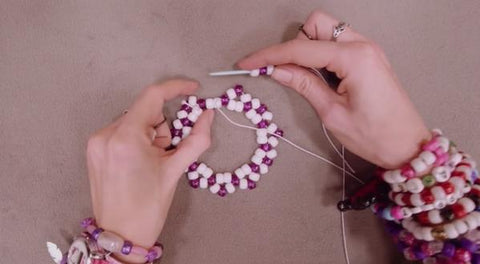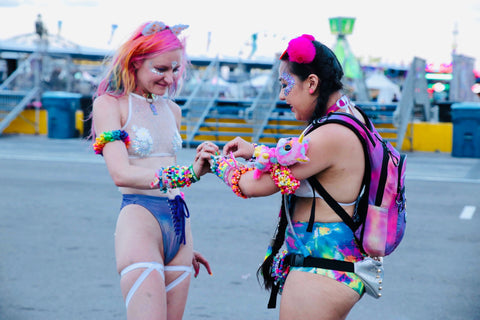You don’t have to spend very much time at a rave or (edm) festival to notice the brightly colored beaded bracelets, necklaces, and accessories that many ravers are wearing. These colorful accessories are called kandi, and they’re a major part of the scene and are totally unique to rave culture.
You may have heard stories or witnessed people swapping kandi around you, usually while doing some type of secret handshake, and you might be curious about what exactly is happening. If you’ve been wondering how to trade kandi at a rave, we’ve got the tips, tricks, and etiquette rules you need to know before you get started.
What is Kandi?
Most people use the term “kandi” to describe brightly colored beaded bracelets that are usually made with pony beads (those plastic beads you used to make bracelets as a kid).
Today, kandi can be used to describe beaded bracelets, necklaces, masks, and even clothing, as people have become more and more creative in the way they use their beads. Kandi is a distinctive and unique part of rave culture and is designed to be given away or traded away as a sign of PLUR culture - peace, love, unity, and respect.

Photo Credit: @sunflowerraver

rolita couture x iHR lucid dream bralette outfit
Where does PLUR come from?
It might seem a bit strange that a subculture would have its own motto, but that’s exactly the case with raves and the PLUR lifestyle. What’s ironic is that the PLUR motto actually came from a decidedly un-PLUR situation.
As the story goes, New York DJ Frankie Bones was playing at a rave in the Bronx on July 24, 1993. A fight broke out in the crowd and ended up spilling over onto Bones’ deck. He grabbed the microphone and shouted “You better start showing some peace, love, and unity or I will break your f*cking faces!”
The story of the humorous moment ended up spreading throughout the 90s rave scene like wildfire and was a testimony to the difficulties and struggles surrounding the early scene.
Ever since, PLUR culture has been synonymous with the rave scene, and today, ravers demonstrate respect and love to everyone while expressing themselves and dancing the night away in peace and unity. Kandi is symbolic of PLUR culture and symbolizes a strong connection made between two people at a rave or festival.

Making Kandi
One of the most special parts of trading kandi actually occurs before the trade even happens while making kandi. Although some people choose to buy kandi, this is generally frowned upon in kandi etiquette , because kandi is supposed to be meaningful, special, and unique.
With that said, if you don’t have time to make kandi before your next festival and you don’t want to show up empty handed, you’ll be forgiven for buying it. Making kandi requires just a few simple supplies. To make kandi, you’ll need:
- Pony beads (or beads of your choice)
- String (elastic string preferred)
- Scissors
- A ruler
If you’re new to making kandi or arts and crafts aren’t exactly your strong suit, start by making a simple single strand bead bracelet. These are the easiest to make and are also the most commonly traded with other people. As a bonus, it’s easy to get creative, and they’re inexpensive to make.
You can personalize your bracelets using letter beads to create phrases or write out the person’s name, and you can also add charms and unique beads that reflect your interests or the interests of the person you’re making them for. Most people wear layers of kandi bracelets stacked up their arms for dramatic effect, but they can also be stitched together to form a cuff if you’re looking to get a little fancier.
Kandi can pretty much be made in any form, including 3D bracelets, necklaces, perlers, masks, and even clothing, if you’re particularly talented with your beadwork.
If you’ve never heard of perlers, they’re a unique type of necklace made of small, heat activated beads (called perler beads) that fuse together when heated. Perlers can be made to resemble certain cartoon characters, shapes, symbols, and patterns, and the only limit on what they can be is your creativity.

Check out this blog post for how to make your own 3D Kandi Cuff!

Trading Kandi
Once you’ve made your kandi, it’s time for the fun part - trading it! While it might seem as simple as walking up to the nearest person and asking to swap, there’s actually some fairly specific kandi trading etiquette that should be followed, and a specific process that usually goes down.
Kandi is traded when you make a special connection with someone, whether it be a person you met in line for the porta-potties, your BFF, or the hot guy dancing next to you all night. This creates special meaning and memories behind the kandi you trade, and those memories can stick with you for years to come.

PLUR Handshake
As a general rule, kandi is always swapped after doing the PLUR handshake. Yes, rave culture has its own secret handshake, and learning it is kandi-essential! To perform the PLUR handshake, you’ll draw out the symbols of the motto with your fingers to spell out P (peace), L (love), U (unity), and R (respect).
- For peace, use your index and middle fingers to make a peace sign and touch your fingers to the other person’s fingers.
- For love, make half of a heart shape with your hand and touch your half to the other person’s half.
- For unity, clasp the other person’s hand and interlock fingers with them.
- For respect, trade your kandi through your interlocked hands, one at a time.
That’s it! If you’re trading necklaces, use both hands to perform the handshake during necklace trades, but otherwise, use just one hand to swap bracelets.

rolita couture x iHR welcome to fantasy land chain outfit
Kandi Trading Etiquette
Now it’s time to discuss a few kandi trading etiquette guidelines. Of course, always do the PLUR handshake when trading kandi, but besides that, you’ll want to follow the rest of these guidelines as well.
- Don’t ask for specific pieces: It’s considered rude to ask for specific pieces of kandi from someone. Kandi should be traded organically, and the person giving you kandi will select a specific piece for you based on qualities that they may see in you, memories you share together, or other meaningful characteristics. Remember, kandi is all about celebrating a connection, and asking for specific pieces of kandi doesn’t help to build that connection.
- Don’t randomly ask for kandi without a connection: We’ve emphasized how important the connection is to kandi trading, so it should go without saying that you need to establish a connection with someone and get to know them before trading. If you approach the first person that you see wearing kandi and ask for some, they will probably still give it to you, but you’re missing the point of trading entirely, which is to share something special.
- Don’t trade pieces that you have received: It’s considered bad form to trade pieces of kandi that have been given to you, since they were given to you based on another person’s connection with you. Many ravers have kandi on one arm that they have been given and on another that they have created to give away. Keep the kandi you’ve received so that you can hold onto the memories associated with them!
- Don’t trade pieces that were made specially for you: Elaborating on the etiquette tip above, never trade kandi pieces that were made specially for you. If someone took the time to make you kandi specifically because they thought you would like it, honor that connection and hold onto it.
- Create the kandi you want to receive: Consider it the golden rule of kandi: create the kandi you want to receive. Remember to put just as much love into creating your kandi as you hope to receive from it.
- Trade something else if you don’t have kandi: If you don’t have any kandi to give away, that’s ok! It’s fine to trade something else in exchange, and sometimes, that can be an even more special way of creating a memory.

liya kitten x iHR kandi land bow outfit
Left Arm vs Right Arm
When it comes to kandi trading, both arms are not created equal. Generally speaking, most kandi traders keep the kandi that they are willing to trade on their right arm and their “untradeable” kandi on their left arm.
Kandi that is untradeable might have special meaning, have been given to the person, or go with the theme of the person’s costume. While everyone is different, this is a general rule. If someone offers for you to choose a piece of kandi when you’re trading, make sure to ask if there are any pieces that are off limits, just to be careful.
Giving Kandi
Of course, you don’t have to trade kandi if you don’t want to - you can just give it away! If you see someone who is kandi-less or who looks particularly lonely or sad, giving them kandi can be a way to lift their spirits and bring them into the PLUR lifestyle. Kandi is about spreading PLUR wherever you go, so take the opportunity to give it away whenever you can.














Comments
This really helped!!! I’m a new Kandi maker and I genuinely didn’t know some of this.. I’ll make sure to wear my untradables on my left from now on!!! X3
like i said before…i always wanted to attend the festival but i have no location or clue where it is held in what states and i need help with that cause i looked under kandi but i found nothing at all and dont know how to say it cause im autistic and my speaking is limited to my knowledge so where is it in the united states of america
I the thing I love most about raves
I’m going to my first EVER EDM festival, EDC Orlando next month! I was a baby raver in the late 90s, and kandi was literally candy necklaces that we would eat off each other’s necks!!! I’m so excited to make and trade! kandi that will represent some really cool memories and people! #PLURalldayeveryday 💖
well, this was very helpful >.<
Thank you for all of the advice! I know that at this point, there might not be many raves to go to, because of the circumstances, but if I ever catch wind of one, or am invited in some way, I’ll definitely go, and I’ll bring some kandi with me! Thanks again!